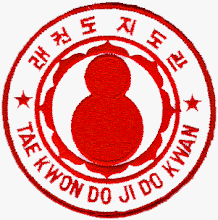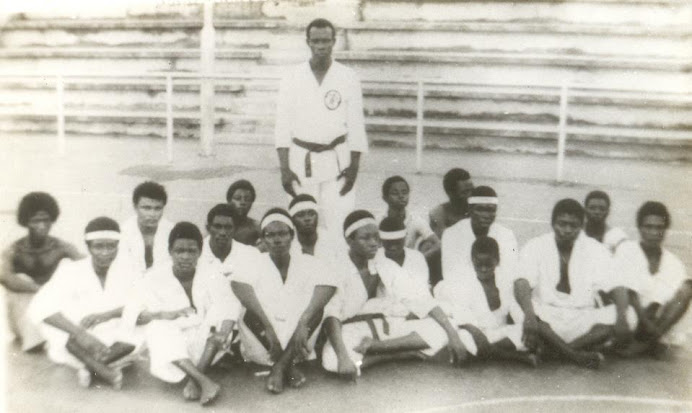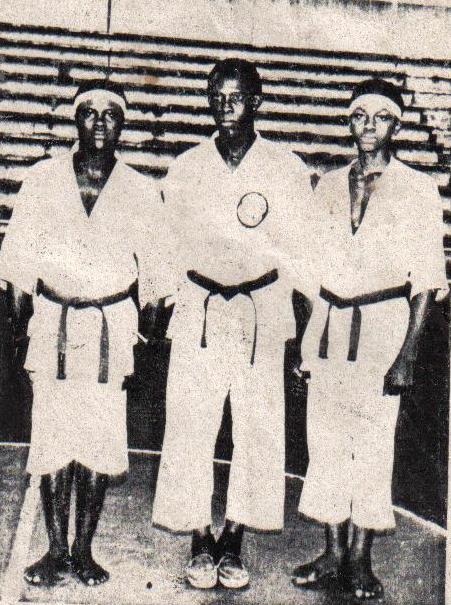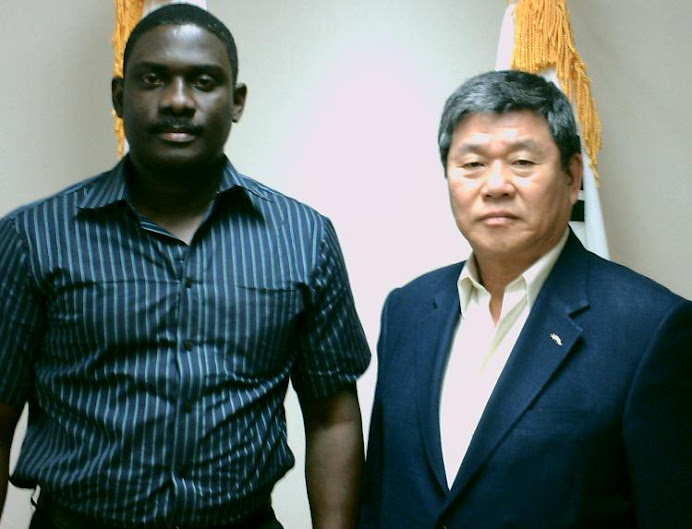FAQ : What is
Martial Art?
GENERAL CHOI SPEAKS :
The term ‘martial art’ means those arts concerned with the waging of war yet,
curiously, very few practice nowadays meet that definition. By far the majority
are relatively recent activities, developed in the 20th century
itself and having only the smallest connection with the battlefield.
The oldest
martial art in evidence came into being about 3500BC. In China there is a
painting in a tomb along the nile with Hieroglyphic inscription and writing and
picture engraved in the pyramid. This proves that the Egyptians had a form of
open hand and foot fighting similar to boxing.
FAQ : What is
True Meaning of Taekwon-Do?
GENERAL CHOI SPEAKS :Translated from Korean ‘Tae’
means literally to jump, kick or smash with the foot; ‘Kwon’ denotes a fist,
chiefly to punch or destroy with the hand or fist; ‘Do’ means art, way or
method. The word themselves, Tae Kwon Do, mean “Hand and Foot Art”. A more
definitive meaning than this is Art and moral conduct.
FAQ : Why is Taekwon-Do Both Martial
Art and Sport?
GENERAL CHOI SPEAKS : Tae Kwon Do can be considered
a martial art and sport as well. Adhering to basic principles is what makes Tae
Kwon Do a martial, a physical art and science and sport.
FAQ : When and How Was Taekwon-Do Born?
GENERAL CHOI SPEAKS : I had been researching, training and teaching Tang Soo. I had created
the name Tae Kwon-Do and by 1955 I felt it was time to announce the new name of
the art. But rather than just proclaim the name myself, I thought it wise to
create the advisory committee for naming.
FAQ :
Which Korean Traditional Martial Arts Schools Were Involved in the Creation of
Taekwon-Do?
GENERAL CHOI SPEAKS : In the late autumn of 1959, I invited the leaders of four major kwans to my
home. Byung Jik No (represented Song Moo Kwan); Kwe Byung Yoon (Jidokwan); Nam
Suk Lee (Chang Moo Kwan); and Ki Hwang (Moo Duk Kwan). I represented Oh Do
Kwan.
FAQ
: To What Extent Was Korean Government Involved in the Formation of
Taekwon-Do?
GENERAL CHOI SPEAKS :…We (advisory committee for naming TKD) received permission to use the new name of Taekwon-Do from President Syngman Rhee (first elected leader of South Korea in 1948, ruled till 1960). In recollection, I think it was possible to make the name “TKD” because I was a two-star general, and had a powerful…and good relationship with President Rhee…The name Taekwon-Do gradually spread through the military ranks and civilian students. The Korean government threw its full support and financially backing behind Taekwon-Do as Korea’s official martial art.
FAQ : What Technical Emphasis Distinguishes Taekwondo from Karate and Kung Fu?
GENERAL CHOI SPEAKS: Taekwon-Do is a scientific martial art based on Newtonian Physics. It must be stressed that Taekwon-Do is not Karate or Kung Fu. It is an original art which employs the extra strength of the legs to good effect by emphasizing jumping and kicking techniques.
FAQ : What Are the Original Ideals for
Practitioners of Taekwon-Do?
GENERAL CHOI SPEAKS: Formulated in March 1955, the
ideals fpr the Taekwondo practitioners are:
1.
By developing an upright mind
and a strong body, we will acquire the self-confidence to stand on the side of
justice at all times.
2.
We shall unite with all men in a
common brotherhood, without regard to religion, race, national or ideological
boundaries.
3.
We shall dedicate ourselves to
building a peaceful human society in which justice, morality, trust and
humanism prevail.
Akin to the above is the Taekwon-Do student
pledge:
1.
I shall observe the Tenets of
Taekwon-Do
2.
I shall respect instructors and
seniors
3.
I shall never misuse Taekwon-Do
4.
I shall be a champion of freedom
and justice
5.
I will build a more peaceful
world
The following Tenets of Taekwon-Do should serve as a
guide for all serious students of the art
- Humility
- Modesty
- Perseverance
- Self-control
- Indomitable Spirit
TAEKWONDO STUDENT PLEDGE:
I shall observe the Tenets of Taekwondo
I shall respect instructors and seniors
I shall never misuse Taekwondo
I will a champion of freedom and justice
I will build a peaceful world
DOJANG RULES OF CONDUCT:
THE DOJANG IS PLACE WHERE TAEKWONDO IS LEARNED PRACTISED AND IS GUIDED
BY CERTAIN INTERNATIONAL NORMS AND PRACTICE AS FOLLOWS:
- Be courteous and helpful to all students and visitors to the Dojang
- Be respectful to senior and acknowledge with bows
- Salute the flag and bow to the instructor upon entering and leaving the Dojang
- Shoes, jewellery, gum or food, alcohol and smoking are not allowed in the Dojang
- Horseplay (i.e. rough play), profanity (abuses words) and idle chatter are strictly prohibited
- Maintain your self-control, never lose your temper or behave irresponsibly
- Keep your Dobok clean and always fold and carry your uniform neatly
- Regularly cut your toe and finger nails short
- Always be neat and tidy observing personal hygiene and grooming habits
- Always endeavour to fulfill your club membership obligations
- Be loyal to your instructor and club & be a good ambassador of Taekwondo Jidokwan
- Keep your training, grading records, certificates and licences meticulously
PREAMBLE BY GEN. CHOI: Since Taekwondo is an art of self defence which aims at a
noble moral rearmament, high degree of intellectual achievement, graceful
techniques, formidable power and beauty of physical form, it can be considered
as a part of one's daily life, just as are breathing and thinking. As the
founder of Taekwon-Do, I would like to define its philosophy, principles, and
purposes so that these might be applied to bring about the flowering of
morality, beauty, and power in harmony with the immortal spirit
PART 1.
Through scientific practice of Taekwondo one can significantly improve his health and nourish his intellect. One can be in a position to aid others in the cause of justice, thereby promoting social ethics and morals, thus helping to bring about a happier and more peaceful society.
PART 2.
In order to come to terms with life, in spite of its detestable aspects, and with the idea of death, one ought to continue studying the art of Taekwondo to learn techniques of power and grace, and to enlarge his spiritual realm. Thus the motivations to study shall be an inheritance to limitless value succeeding generations.
PART 3.
Human beings come into the world with simple needs and desires. They need not become avaricious but ought to remain always humble and merciful, never compromise their principles, nor be swayed by selfish motives, to insure freedom and independence of Taekwon-Do so that it will be passed on in its pure form.
PART 4.
Since all students of the art are subject to the same rules of conduct and judged according to the same criteria regardless of their stations in life, their origins, and their religious convictions, they demonstrate to the world the essential equality and brotherhood of man.
PART 5.
Modern society is characterized by selfish preoccupation with material excess and unnecessary dependence on machines. Moral society is characterized by self discipline, sacrifice, and devotion. Dedication to the art can promote change toward a moral society.
PART 6.
Those who devote themselves to their fellows and live accordingly to the dictates of their consciences are always helpful toward their juniors and show respect toward their instructors and their seniors.
A beginning constitutes a significant part of the whole endeavour. Therefore, students of Taekwon-Do should not fail to take action whenever to do so might benefit the society. If he behaves thus, he himself will benefit most.
PART 1.
Through scientific practice of Taekwondo one can significantly improve his health and nourish his intellect. One can be in a position to aid others in the cause of justice, thereby promoting social ethics and morals, thus helping to bring about a happier and more peaceful society.
PART 2.
In order to come to terms with life, in spite of its detestable aspects, and with the idea of death, one ought to continue studying the art of Taekwondo to learn techniques of power and grace, and to enlarge his spiritual realm. Thus the motivations to study shall be an inheritance to limitless value succeeding generations.
PART 3.
Human beings come into the world with simple needs and desires. They need not become avaricious but ought to remain always humble and merciful, never compromise their principles, nor be swayed by selfish motives, to insure freedom and independence of Taekwon-Do so that it will be passed on in its pure form.
PART 4.
Since all students of the art are subject to the same rules of conduct and judged according to the same criteria regardless of their stations in life, their origins, and their religious convictions, they demonstrate to the world the essential equality and brotherhood of man.
PART 5.
Modern society is characterized by selfish preoccupation with material excess and unnecessary dependence on machines. Moral society is characterized by self discipline, sacrifice, and devotion. Dedication to the art can promote change toward a moral society.
PART 6.
Those who devote themselves to their fellows and live accordingly to the dictates of their consciences are always helpful toward their juniors and show respect toward their instructors and their seniors.
A beginning constitutes a significant part of the whole endeavour. Therefore, students of Taekwon-Do should not fail to take action whenever to do so might benefit the society. If he behaves thus, he himself will benefit most.
COMPOSITION OF TAEKWONDO
Taekwondo
is composed of fundamental movements, patterns, dallyon, sparring and
self-defence techniques that are so closely related that it is impossible to
segregate one phase of instruction from another. Fundamental movements are
necessary for sparring and patterns, while both patterns and sparring are
indispensable for perfection of fundamental movements.
As
in military training, Taekwondo progression follows a certain parallel:
1. Fundamental Movements2. Tallyeon
3. Patterns
4. Sparring
5. Self-defence
4. Sparring
5. Self-defence
= Maintenance of equipment
= Platoon tactics
= Field exercises in simulated combat conditions
= Actual Combat
= Individual soldier's basic training= Field exercises in simulated combat conditions
= Actual Combat
THE PHILOSOPHY OF
TAEKWONDO
The
philosophy of Taekwondo is based on the ethical, moral, and spiritual standards
by which men can live together in harmony, and its art patterns are inspired by
the ideals...from Korean history. Therefore, under no circumstances should
Taekwondo be used for any commercial or political purpose whatsoever.
I
have set forth the following philosophy and guidelines which will be the
cornerstone of Taekwondo and by which all serious students of this art are
encouraged to live.
1. Be willing to go where the going may be tough and do the things that are worth doing even though they are difficult.
2. Be gentle to the weak and tough to the strong.
3. Be content with what you have in money and position but never in skills.
4. Always finish what you begin, be it large or small.
5. Be a willing teacher to anyone regardless of religion, race or ideology.
6. Never yield to repression or threat in the pursuit of a noble cause.
7. Teach attitude and skill with action rather than words.
8. Always be yourself even though your circumstances may change.
9. Be the eternal teacher who teaches with the body when young, with words when old, and by moral precept even after death.









































































































































































































I implied simply tying them on and indicate how they sit on the abdomen out of the container.Karate Belt Display UK Utilizing and softening them all up would be insane.
ReplyDelete